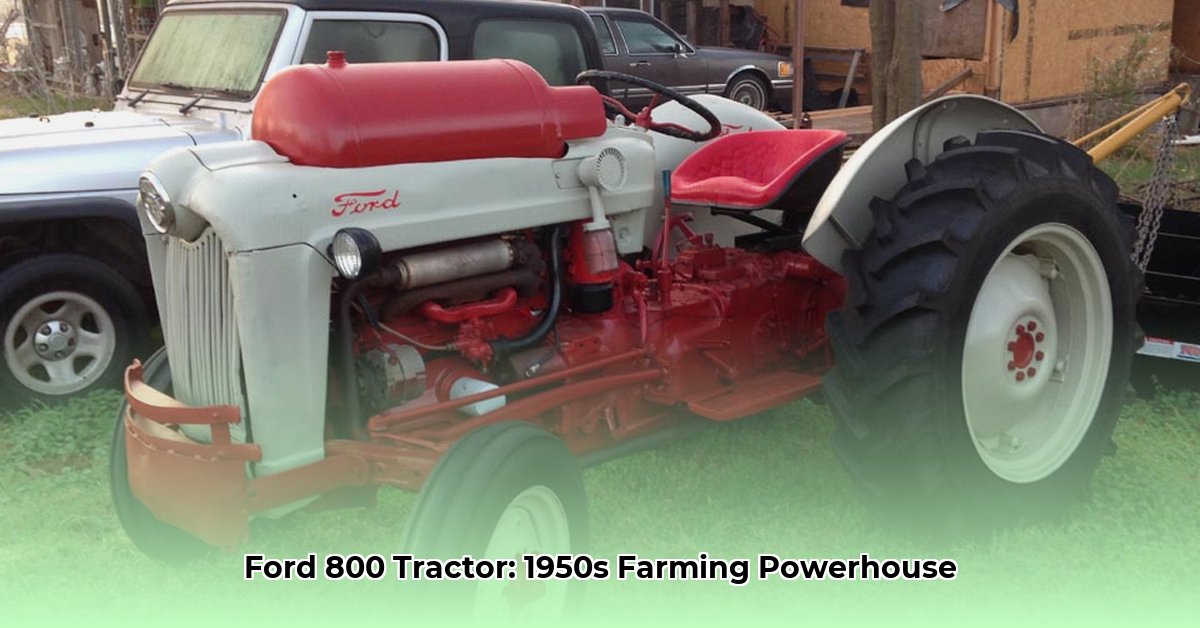
The Ford 800 tractor—a stalwart of 1950s agriculture—represents a pivotal moment in farming mechanization. This article delves beyond a simple specification list, exploring its impact on agricultural practices and its legacy concerning sustainable farming, acknowledging the vastly different environmental consciousness of its era. We will examine its technical specifications, historical context, and analyze its sustainability implications relative to both its time and modern standards. For more detailed specifications, see the Ford 800 specs.
The Ford 800's Mechanical Heart: Engine and Performance
The Ford 800 boasted a robust 2.8-liter four-cylinder engine, a significant upgrade from its predecessors. Fueled by either gasoline or liquid propane gas (LPG), it generated approximately 35-40 horsepower. This power increase dramatically sped up fieldwork, leading to quicker plowing, harvesting, and overall increased acreage cultivated daily. However, this increased efficiency also presented challenges. Did the added workload negatively impact farmer health and well-being? Further research into the social impact of these productivity increases is warranted.
Fueling the Fields: Fuel Efficiency and Tank Capacity
Fuel efficiency was paramount in the 1950s. The Ford 800's 14-gallon fuel tank, while modest by today's standards, likely dictated farming strategies. Farmers needed to carefully plan their routes and refueling stops, a constraint absent in modern farming with larger fuel tanks. This necessity fostered a nuanced understanding of fuel management, contrasting with the less fuel-conscious practices of today. This highlights the differing approaches to resource management across eras.
Size and Strength: Dimensions and Operational Weight
Balancing maneuverability and stability was crucial. The Ford 800 weighed approximately 2850 to 3400 pounds. This weight provided stability for heavier tasks, but navigating smaller fields or soft terrain would have presented challenges. Precise dimensional data for various models within the 800 series remains elusive, hindering complete analysis.
Hydraulic Advancements: A Technological Leap Forward
The Ford 800's open-center hydraulic system was a key innovation, simplifying the operation of attached implements. However, potential drawbacks existed. Hydraulic fluid leaks were possible, posing environmental concerns by today's standards. The type of fluid used and its disposal methods require further investigation to fully assess their environmental impact.
Variations within the Series: Model Specificity
The Ford 800 series wasn't monolithic. Slight variations in specifications existed across different models.
| Model | Engine Type | Horsepower (approx.) | Weight (approx. lbs) | Key Differences |
|---|---|---|---|---|
| 820 | Gasoline/LP Gas | 35 | 2850 | Base model, providing a solid base performance |
| 840 | Gasoline/LP Gas | 38 | 3000 | Slightly more powerful and heavier |
| 850 | Gasoline/LP Gas | 40 | 3200 | More powerful and heavier |
| 860 | Gasoline/LP Gas | 40 | 3400 | Heaviest model, better suited for heavy tasks |
These variations reflected Ford's attempt to adapt to the diverse needs of various agricultural operations.
Sustainability Analysis: A 1950s Perspective
The Ford 800's reliance on gasoline or LPG contrasts sharply with modern sustainable practices emphasizing biofuels and electric power. Manufacturing processes, material usage, and disposal methods weren't subject to the same environmental scrutiny as today. Evaluating its impact requires understanding the limited environmental awareness of its era while acknowledging it nevertheless set the stage for future advancements in sustainable agricultural technology.
The Ford 800's Enduring Legacy: Impact and Considerations
Despite its limitations from a modern sustainability perspective, the Ford 800 profoundly impacted agriculture. Its increased efficiency and affordability catalyzed mechanization, boosting productivity and helping to feed a growing global population. Its story serves as a reminder of the continuous evolution of agricultural technology and the vital need to integrate environmental considerations from the initial design phase.
Key Takeaways:
- Increased agricultural efficiency was a hallmark of the Ford 800 series.
- Its widespread adoption accelerated mechanization in farming.
- Higher crop yields contributed significantly to feeding a growing population.
- Fuel consumption and increased fertilizer use raise contemporary sustainability questions.
- Assessing the Ford 800's environmental effect necessitates comparing it to both its contemporary standards and modern, more environmentally conscious practices.